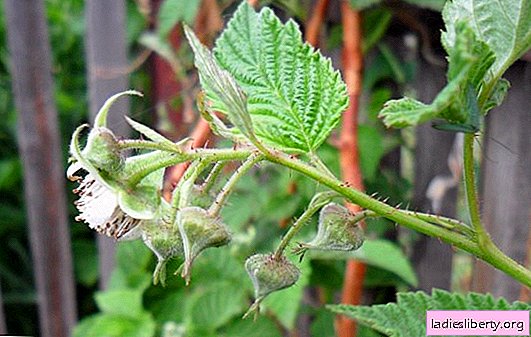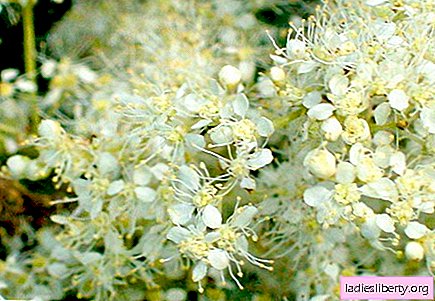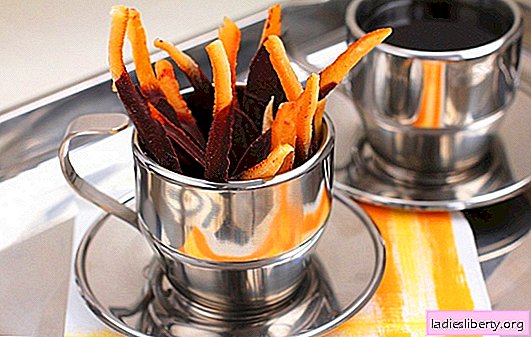
You can get a good crop from raspberries only with proper cultivation and care.
Raspberry is a rather undemanding plant, however, without proper care, it is often attacked by pests and diseases, which significantly reduce the yield and winter hardiness of the bush.
Many gardeners often observe the wilting of young shoots of raspberries, which had developed well yesterday. What is the reason and how to deal with the wilting of shoots on raspberries?
Why fade shoots of young raspberries
Often, the wilting of young branches indicates that the bush is affected by pests. As a rule, the tops of young shoots stop developing and wither when they are infected with fungal diseases and harmful insects:
• raspberry fly;
• gall midge;
• purple spotting.
Often, only a pruned shoot will help save the bush. There should not be a single hole and larva on the plant. Strong and healthy bushes will be able to quickly recover and grow young shoots, on which the crop will ripen.
The use of chemicals is justified when pests hit more than 50% of the plantings.
How to deal with a raspberry stem fly
Recognize a pest on raspberries by the condition of the bush. The tops of the stems wither, the leaves turn black and die.
To combat this pest, you need to understand how it develops. A fly overwinters in the soil, and in mid-May it comes to the surface and begins to lay larvae in the axils of the apical leaves of raspberries. The larvae of the stem fly gnaw out a course in a young shoot, which causes its withering and further death.
At the first signs of wilting of young shoots, it is necessary to cut off the affected areas to healthy tissue. All trimmed parts of the branches are burned, the soil under the bush is loosened and treated with a solution of nitrophene. For prophylaxis in the fight against raspberry fly, when buds appear, they spray the karbofos shrub.
You can avoid raspberry infection with a stem fly by properly caring for the plantings.
• For winter all leaves and debris must be removed from under the bushes. The soil must be loosened and cultivated. It is important to remember that pests and dangerous bacteria hibernate under the remains of leaves, which begin to multiply actively in spring. By arranging plantings for winter, the gardener reduces the risk of diseases and increases the immunity of plants.
• Spring cleaning the site is no less important than winter. After the winter, all accumulated debris needs to be removed, loosened the ground again and feed the plantings. Proper nutrition of the bush is the key to a good harvest. Healthy plants resist any disease.

Gallica on raspberries
Inexperienced gardeners complain that young raspberries fade together with flowers and berries. In mid-summer, a gall midge leads to such a problem. You can detect the pest with a thorough inspection of the bush in early spring and autumn. When there are no leaves on raspberries, then on the branches thickenings are clearly visible - galls, in which larvae are located. The pest settles on the lower part of the plant, closer to the root.
Affected shoots weaken the bush, reduce its winter hardiness. In one season, several generations of gall midges can develop, which form more and more swellings on raspberries. The process continues until the first frost. Pests overwinter in soil at a depth of 30 cm.

How to deal with the gall midge
Pest control is carried out by spring pruning raspberries, sanitary cleaning: cut out all damaged shoots, thin out the bush. Gauls love to settle on those shrubs that are affected by fungal diseases. Therefore, the main struggle must be waged with a fungus on raspberries. In order to prevent fungal diseases, plantings are sprayed with Bordeaux liquid until the buds open.
The spread of the fungus is prevented by the summer pruning of the deflated branches of raspberries. First, the shoots that are repelled are cut in early varieties, then in medium varieties, and in autumn in late raspberry species.
After such pruning, spraying with preparations containing copper is carried out. Repairing varieties are sprayed to the first flower brush. It is necessary to carry out processing in the evening when there are no bees.
In the fight against gall midges, you need to conduct daily inspection of plantings and cut shoots with galls at the initial stage. In the spring, shoots above the swelling do not develop and wither. In this case, the top of the branch is cut 1-2 cm below the lesion.
To successfully combat the gall midge, alternative drugs are used that repel the pest. For this purpose, infusions of mullein, walnut leaves, wormwood and nettle are used. Between raspberry bushes, you can plant garlic and perennial onions. The smell of these plants does not like gall midge. Spraying with infusions of herbs is necessary in the evening, because gall midges fly at night.
A dangerous and widespread disease - purple spotting - leads to the death of 50% of the landings. The causative agent of the disease is a fungus that penetrates the plant and weakens it. As a result, shrubs are attacked by gall midges.
Purple spotting appears in mid-summer. Raspberry stalks are affected by blurry spots that spread throughout the plant: raspberry shoots wither, petioles and leaves die, fruits dry out. The shrub dies before the fruit ripens.
If measures to combat the disease are not taken in time, by the fall a lot of fungal spores will form, which are transferred to healthy plants. The spores of the fungus overwinter on damaged stems. In the conditions of a warm winter, new shoots continue to develop and hit.

How to deal with the disease
To successfully combat the disease, preventive measures must be taken. This is how the spread of the disease can be prevented.
• Affected shoots are cut under the root, not sparing the bush.
• In summer, thinning of plantings is carried out, thickening provokes the spread of fungus.
• Carry out proper shrub planting. A place for planting seedlings should not be located in a lowland and near water bodies.
• Observe the watering regime, avoiding overmoistening of the soil.
• Timely remove weeds and loosen the soil around the bush.
• Use resistant raspberry varieties and healthy seedlings for planting.
Spring pruning will help protect raspberries from being affected by purple spotting. When the bush is formed, the repelled branches are cut out, as well as young weak shoots that will not bring a crop.
Important! All cut shoots must be burned. Mushroom spores can germinate over several years.
If these measures are not enough, then to fight the disease, chemicals are used:
• Azophos 50%. For 10 liters of water use 80 grams of the drug.
• Bordeaux mixture 1%. For 10 liters of water take 100 grams of lime and copper sulphate.
• Nitrofen solution. In 10 liters of water, 300 grams of the drug is diluted.
• 1% ready-made DNOC solution.
Processing with drugs is carried out before flowering, as well as immediately after harvest.
A fungal disease of raspberries that spreads to the bark, shoots and rhizomes of a plant. Recognizing the affected bush is simple: young flow and shoots turn yellow, the tops fade. Raspberry stalks slow their growth and die off.

The disease is not treatable. Damaged plants should be removed along with the rhizome and burned. A healthy planting material, loosening the soil will help prevent the disease.











